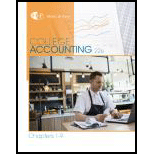
Prepare the
Explanation of Solution
A partnership is an unincorporated form of business which is formed by an agreement, owned and managed mutually by two or more individuals, who invest their assets in the business and share the liabilities and profits among themselves.
Prepare the journal entry:
| Date | Account titles and Explanation | Debit | Credit |
| January 1 | Cash | $600,000 | |
| Inventory | $400,000 | ||
| Gain on sale of assets | $200,000 | ||
| (To record sale of inventory) |
Table (1)
- Cash is an asset and it is increased. Therefore, debit cash account by $600,000.
- Inventory is an asset and it is decreased. Therefore, credit inventory account by $400,000.
- Gain on sale of assets is a component of partners’ equity and it is increased. Therefore, credit gain on sale of assets account by $200,000.
| Date | Account titles and Explanation | Debit | Credit |
| January 1 | Gain on sale of assets | $200,000 | |
| Partner P, Capital | (1) $60,000 | ||
| Partner JM, Capital | (2) $60,000 | ||
| Partner JS, Capital | (3) $40,000 | ||
| Partner M, Capital | (4) $40,000 | ||
| (To record allocation of gain) |
Table (2)
- Gain on sale of assets is a component of partners’ equity and it is decreased. Therefore, debit gain on sale of assets account by $200,000.
- Partner P, Capital is a component of partners’ equity and it is increased. Therefore, debit Partner P account by $60,000.
- Partner JM, Capital is a component of partners’ equity and it is increased. Therefore, debit Partner JM account by $60,000.
- Partner JS, Capital is a component of partners’ equity and it is increased. Therefore, debit Partner JS account by $40,000.
- Partner M, Capital is a component of partners’ equity and it is increased. Therefore, debit Partner M account by $40,000.
Working notes:
(1) Calculate the share of gain on sale of assets for Partner D:
(2) Calculate the share of gain on sale of assets for Partner JM:
(3) Calculate the share of gain on sale of assets for Partner JS:
(4) Calculate the share of gain on sale of assets for Partner M:
Want to see more full solutions like this?
Chapter 19 Solutions
College Accounting, Chapters 1-9 (New in Accounting from Heintz and Parry)
- 1. Define working capital and explain its importance in financial health and liquidity management. 2. Assess how the matching concept and accrual basis affect the reporting of current assets and liabilities. 3. Using a hypothetical balance sheet (you may create one), identify at least 5 current assets and 5 current liabilities and analyze how changes in these elements affect liquidity ratios. 4. Recommend at least two strategies VinGrenDom Ltd. can implement to optimize working capital.arrow_forwardNonearrow_forwardNo Ai Answerarrow_forward
- I need the correct answer to this financial accounting problem using the standard accounting approach.arrow_forwardTheron Interiors manufactures handcrafted cabinetry and uses a process costing system. During the month of October, the company started Production on 720 units and completed 590 units. The remaining 120 units were 60% complete in terms of materials and 40% complete in terms of labor and overhead. The total cost incurred during the month was $45,000 for materials and $31,200 for labor and overhead. Using the weighted-average method, what is the equivalent unit cost for materials and conversion costs (labor and overhead)?arrow_forwardGeneral Accountingarrow_forward
- Kamala Khan has to decide between the following two options: Take out a student loan of $70,000 and study accounting full time for the next three years. The interest on the loan is 4% per year payable annually. The principle is to be paid in full after ten years. Study part time and work part time to earn $15,000 per year for the following six years. Once Kamala graduates, she estimates that she will earn $30,000 for the first three years and $40,000 the next four years. Kamala's banker says the market interest for a ten-year horizon is 6%. Required Calculate NPV of the ten-year cash flows of the two options. For simplification assume that all cash flows happen at year-end. Based on the NPV which of the two options is better for Kamala?arrow_forwardFinancial Accountingarrow_forwardPlease give me answer with general accountingarrow_forward
 College Accounting, Chapters 1-27AccountingISBN:9781337794756Author:HEINTZ, James A.Publisher:Cengage Learning,
College Accounting, Chapters 1-27AccountingISBN:9781337794756Author:HEINTZ, James A.Publisher:Cengage Learning,
